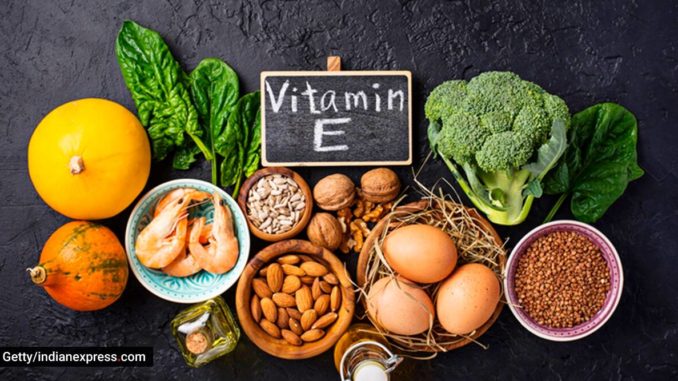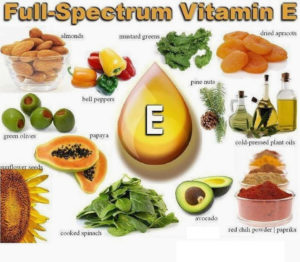
Table of Contents
What is Vitamin E?
- “Vitamin E” is a fat-soluble vitamin with specific antioxidant properties.
- Vitamin E is a nutrient that’s important to vision, reproduction, and the health of your blood, brain and skin.
- Vitamin E is an important type of vitamin that is required for proper function of many organs in the body.
- Vitamin E is found in several forms but alpha-tocopherol is the only one that is used by the body. Therefore, it is also sometimes referred to as tocopherol.
- There are eight chemical variations of vitamin E that are found in nature, each of which has a different amount of biological activity. The only type of tocopherol recognized as meeting human needs is alpha- (or -) tocopherol.
- Its primary function is to serve as an antioxidant by scavenging loose electrons, or “free radicals,” which can harm cells.
- Vitamin E strengthens the body’s natural defenses against disease and infection and keeps the skin and eyes healthy.
Sources of Vitamin E
- Plant-based oils, nuts, seeds, fruits, and vegetables all contain vitamin E
- Wheat germ oil
- Sunflower, safflower, and soybean oil
- Sunflower seeds
- Almonds
- Peanuts, peanut butter
- Beet greens, collard greens, spinach
- Pumpkin
- Red bell pepper
- Asparagus
- Mango
- Avocado
Functions
- Vitamin E has anti-oxidant properties. This means that the vitamin guards against the harm that so-called free radicals may do to bodily tissue. (Note: Free radicals can cause damage to organs, tissues, and cells. They are believed to contribute to a few aging-related diseases)
- It aids in the formation of red blood cells, widens blood arteries to prevent blood clots inside them,
- It strengthens the immune system against bacteria and viruses
- It supports in the body’s use of vitamin K.
- Vitamin E is also used by cells to communicate with one another. It supports them in performing several crucial functions
Recommended Dietary Allowance (RDA)
The amount of vitamin E needed each day depends on age. The recommended dietary allowance (RDA) is:
- Birth to 6 months: 4 mg
- 7months to 1 year: 5 mg
- Children 1-3 years: 6 mg
- Children 4-8 years: 7 mg
- Children 9-13 years: 11 mg
- 14 years and above: 15 mg
- Pregnant women: 15 mg
- Lactating women: 19 mg
Those who are most at risk for vitamin D deficiency can require more
Health Benefits of Vitamin E
- High dosages of vitamin E can lower oxidative stress indicators and strengthen antioxidant defenses
- In some individuals it functions as a potent antioxidant in the body.
- High blood pressure and blood lipid levels such as LDL (bad) cholesterol and triglycerides may raise chance of getting heart disease.
- In some people, taking vitamin E supplements may help lower risk factors for heart disease.
- People with nonalcoholic fatty liver disease may see some health benefits from taking vitamin E supplements
- Vitamin E helps manage dysmenorrhea, and also lessens severe and persistent menstrual discomfort, including cramps and pelvic pain.
- For people suffering from certain skin conditions like eczema, vitamin E is beneficial.
- Keeping vitamin E levels at their ideal range may help prevent future cognitive impairment.
- As vitamin E plays vital functions in health, such as lowering inflammation and enhancing immune function, supplements may benefit persons who have higher demands or do not obtain enough in their diets, such as certain elderly people.
- Studies have revealed that children and adults who use vitamin E supplements may see improvements in their lungs health and some asthmatic symptoms.
Research Evidences
Researches on Vitamin E for different conditions show the following results:
- Alzheimer’s disease: Researches have revealed that high dose of Vitamin E delays the progression of Alzheimer’s disease.
- Liver disease: Vitamin E might improve symptoms of nonalcoholic fatty liver disease.
- Prostate cancer: Use of vitamin E supplements might increase the risk of prostate cancer.
Signs and Symptoms of Vitamin E Deficiency
- Retinopathy (damage to the retina of the eyes)
- Rough skin with bumps
- Decreased immune function
- Body Hair with a Corkscrew Shape
- Bright Red Hair Follicles
- Red Lines or Spots on Spoon-Shaped Fingernails
- Damaged, dry skin
- Easy Bruising
- Taking Time to Heal Wounds
- Ataxia (loss of control of body movements)
- Painful, Swollen Joints
- Weak Bones
- Gum disease and tooth loss
- Poor Immunity
- Chronic iron deficiency Anemia
- Fatigue and Poor Mood
- Unexplained Weight Gain
- Chronic Inflammation and Oxidative Stress
Consequences of Deficiency
- Lack of vitamin E can weaken muscles, impair reflexes and coordination, and make it difficult to walk.
- The deficit can cause a serious form of anemia in premature infants.
- The deficit can cause a serious form of anemia in premature infants.
- The longer a person is vitamin E deficient, the more likely they are to have complications.
- Some conditions are severe and can need medical attention. Some such complications include:
- Blepharoptosis
- Retinal pathology
- Muscle weakness
- Thrombocytosis
- Ataxia
- Anemia
- Sensory ataxia
- Vibration sense loss
- Diplopia, binocular
Groups/Persons At High Risk of Vitamin E Deficiency
- Due to the fact that very little vitamin E crosses the placenta, newborns have a relatively low vitamin E reserve.
- Therefore, neonates, especially preterm newborns, are more likely to have vitamin E deficiency.
- This risk can be raised by specific diseases and health issues, and in some cases, a serious deficiency can result.
- The following medical conditions can increase a person’s risk of vitamin E deficiency:
- Chronic pancreatitis
- Cholestasis
- Cystic fibrosis
- Primary biliary cirrhosis
- Crohn’s disease
- Short bowel syndrome
Safety and Side effects of Vitamin E
Rarely, oral use of Vitamin E can cause following symptoms:
- Nausea
- Diarrhea
- Intestinal cramps
- Fatigue
- Weakness
- Headache
- Blurred vision
- Rash
- Gonadal dysfunction
- Increased concentration of creatine in the urine (creatinuria)
Therefore, one must consult a doctor if you have following symptoms:
- A vitamin K deficiency
- An eye condition in which the retina is damaged (retinitis pigmentosa)
- Bleeding disorders
- Diabetes
- A history of a previous heart attack or stroke
- Head and neck cancer
- Liver disease
References and For More Information
https://www.hsph.harvard.edu/nutritionsource/vitamin-e/
https://www.webmd.com/vitamins/ai/ingredientmono-954/vitamin-e
https://www.mayoclinic.org/drugs-supplements-vitamin-e/art-20364144
https://www.nhs.uk/conditions/vitamins-and-minerals/vitamin-e/
https://ods.od.nih.gov/factsheets/VitaminE-HealthProfessional/
https://www.healthline.com/health/all-about-vitamin-e#58.-Other-potential-health-benefits
https://medlineplus.gov/vitamine.html
https://iubmb.onlinelibrary.wiley.com/doi/10.1002/iub.1990
https://www.healthdirect.gov.au/vitamin-e-and-your-health
https://lpi.oregonstate.edu/mic/vitamins/vitamin-E
https://examine.com/supplements/vitamin-e/
https://www.msdmanuals.com/home/disorders-of-nutrition/vitamins/vitamin-e-deficiency
https://www.sciencedirect.com/topics/agricultural-and-biological-sciences/vitamin-e-deficiency
